2-8-2 "Mikado" Locomotives: History, Survivors, Photos
Last revised: November 1, 2024
By: Adam Burns
The Mikado type was the workhorse steam locomotive
for the railroad industry during the 20th century and prior to the
switch to diesel-electric technology. The design is often regarded as
the classic American steam locomotive for this very reason.
The 2-8-2 design (a blend of the 2-8-0 and 2-6-2 wheel arrangements) offered just the right amount of power, pull, and speed to be used for about any type of service, from passenger trains to freights moving over stiff grades.
Additionally, they were built to both standard as well as narrow-gauge applications. While the wheel arrangement had its origins in Japan the World War II conflict resulted in a number of railroads deciding to rename their fleets to remove any association with that country.
With so many Mikados manufactured over the years numerous examples remain preserved today and several of those are still operational.
Like the Consolidation, the 2-8-2 has become an attractive candidate for restoration. Today, you can find several in operation, in particular at the Durango & Silverton Narrow-Gauge and Cumbres & Toltec Scenic which maintain several of Rio Grande's fabled narrow-gauge Mikado's.
Photos
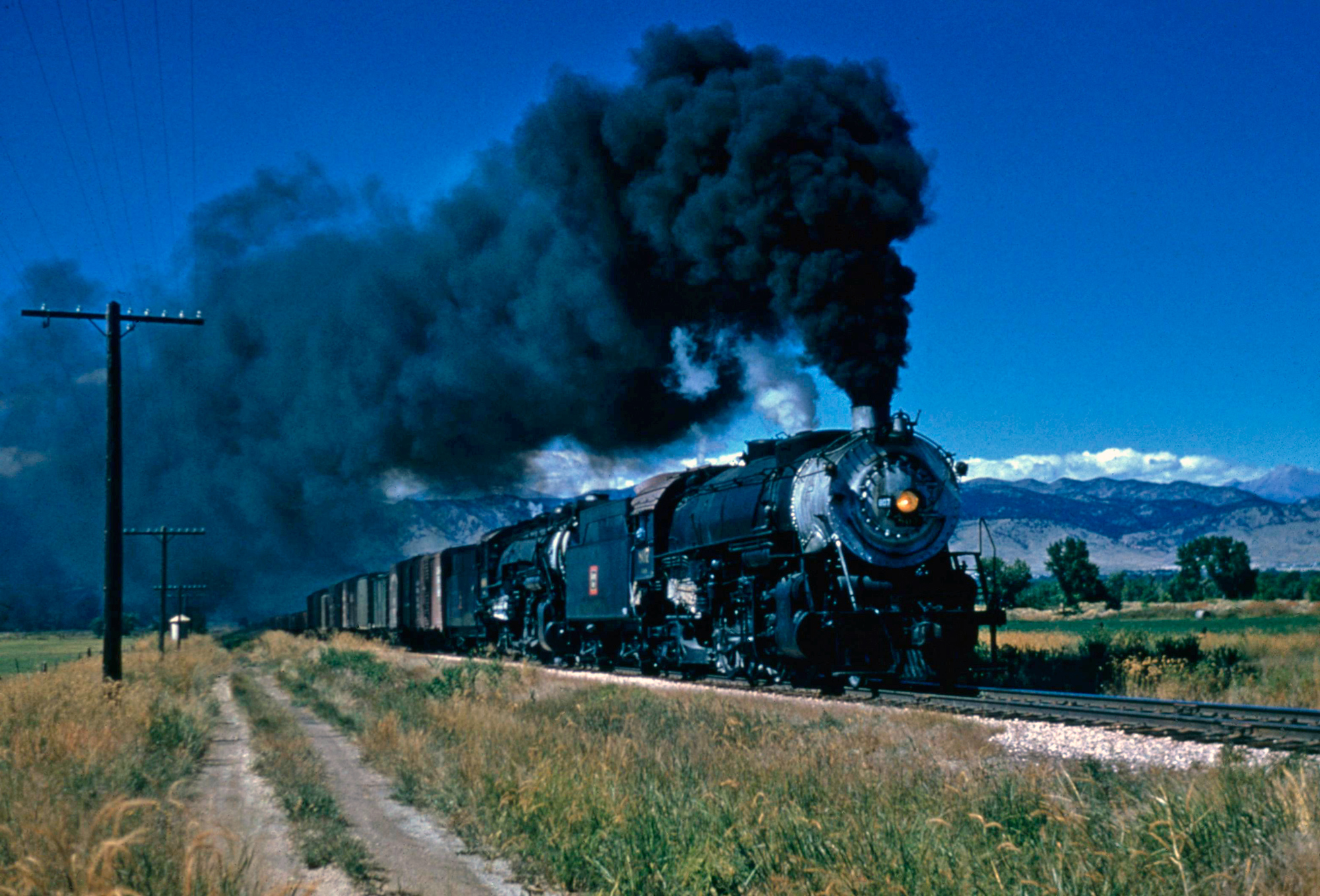 Colorado & Southern 2-8-2's, led by #807, double-head this freight near Boulder, Colorado on September 14, 1957. Author's collection.
Colorado & Southern 2-8-2's, led by #807, double-head this freight near Boulder, Colorado on September 14, 1957. Author's collection.History
The history of the Mikado type in reference to simply the wheel arrangement itself has quite an interesting history. The very first locomotive ever operated as a 2-8-2 design is said to have been an experimental built by the Lehigh Valley.
The railroad took one of its 2-10-0 Camelbacks and cut it down into a 2-8-2 with the belief that it would reduce flange wear on the rear set of drivers.
While the LV went on to become one of the early pioneers of the 2-8-2 the wheel arrangement was mostly shelved within the U.S. railroad industry for the following two decades. Ten years after the LV's first experiment Baldwin Locomotive Works built a fleet of narrow-gauge (three-foot, six-inch) 2-8-2s for the Japan Railways in 1893.
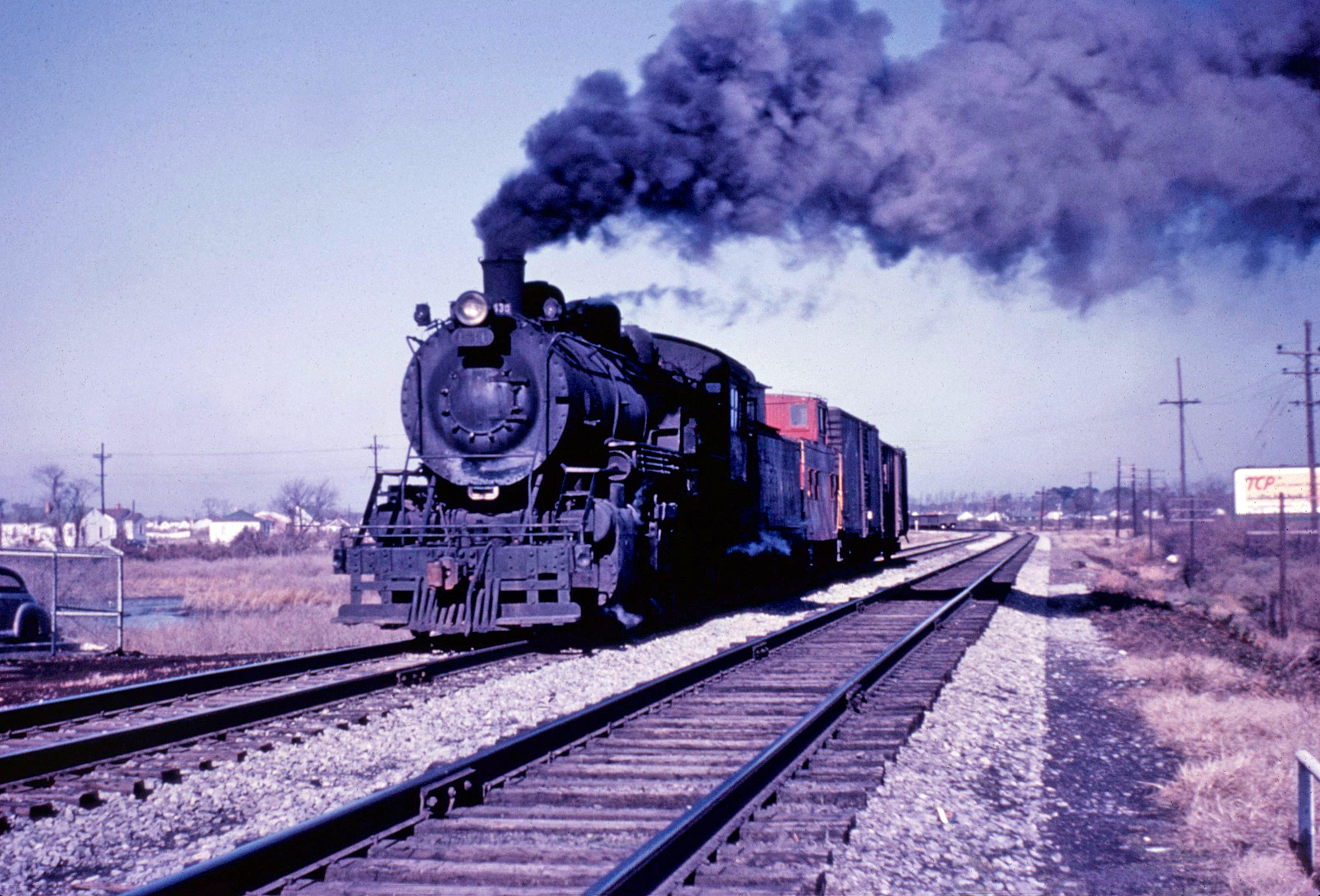 Virginian Railway 2-8-2 #430 works local service in Norfolk, Virginia; December, 1954. H. Reid photo. American-Rails.com collection.
Virginian Railway 2-8-2 #430 works local service in Norfolk, Virginia; December, 1954. H. Reid photo. American-Rails.com collection.Early Examples
It is here where the term Mikado, which refers to a Japanese emperor, is said to have been applied to the 2-8-2 design. In 1903 the LV came back to the wheel arrangement, purchasing 47 examples as Camelbacks by 1905 (#220-267), which featured Wooten fireboxes.
Of course, Camelbacks were a unique design that utilized a cab, which sat atop the boiler. The arrangement never caught on with most railroads due to the fact that it was designed to burn anthracite coal (found only in the Northeast) and was extremely uncomfortable for crews to operate.
The first 2-8-2s employed in standard road service that featured the larger fireboxes and boilers (for increased steam pressure, and thus, more power) is often credited to the Virginian Railway; in 1909 the coal-hauler acquired a fleet of 42 units from Baldwin (#420-461) listed as Class MB that provided tractive efforts greater than 53,000 pounds.
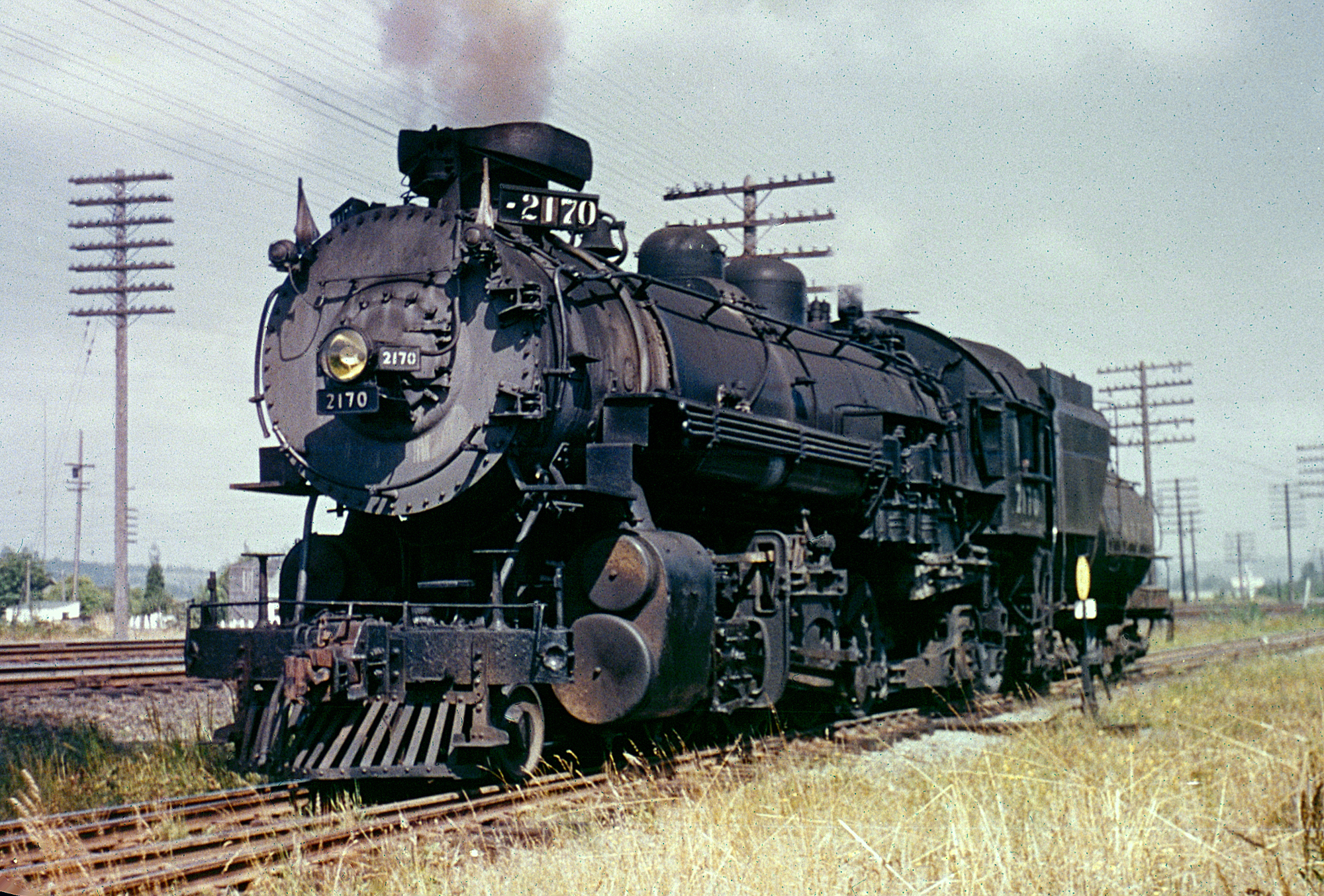 Union Pacific 2-8-2 #2170. Date and location not provided. This locomotive, a Class MK-8, was originally built for subsidiary Oregon-Washington Railroad & Navigation in 1918 by Baldwin. Stephen Bogen photo. American-Rails.com collection.
Union Pacific 2-8-2 #2170. Date and location not provided. This locomotive, a Class MK-8, was originally built for subsidiary Oregon-Washington Railroad & Navigation in 1918 by Baldwin. Stephen Bogen photo. American-Rails.com collection.Other railroads to use early examples of the 2-8-2 include the Bismark, Washburn & Great Falls Railway which used a few beginning in 1903 and the Northern Pacific's initial batch of 1905 (often credited with kicking off interest in 2-8-2s as main line road power).
Up to that time the standard main line wheel arrangement within the industry was the common 2-8-0 Consolidation. While this design continued to be improved upon through the 1920s its size eventually limited further enhancements.
As the Mikado type slowly took over where the Consolidation had left off it, too saw improvements and upgrades as new technologies arrived such as superheaters, boosters, feedwater heaters, mechanical stokers, and later examples were oil burners.
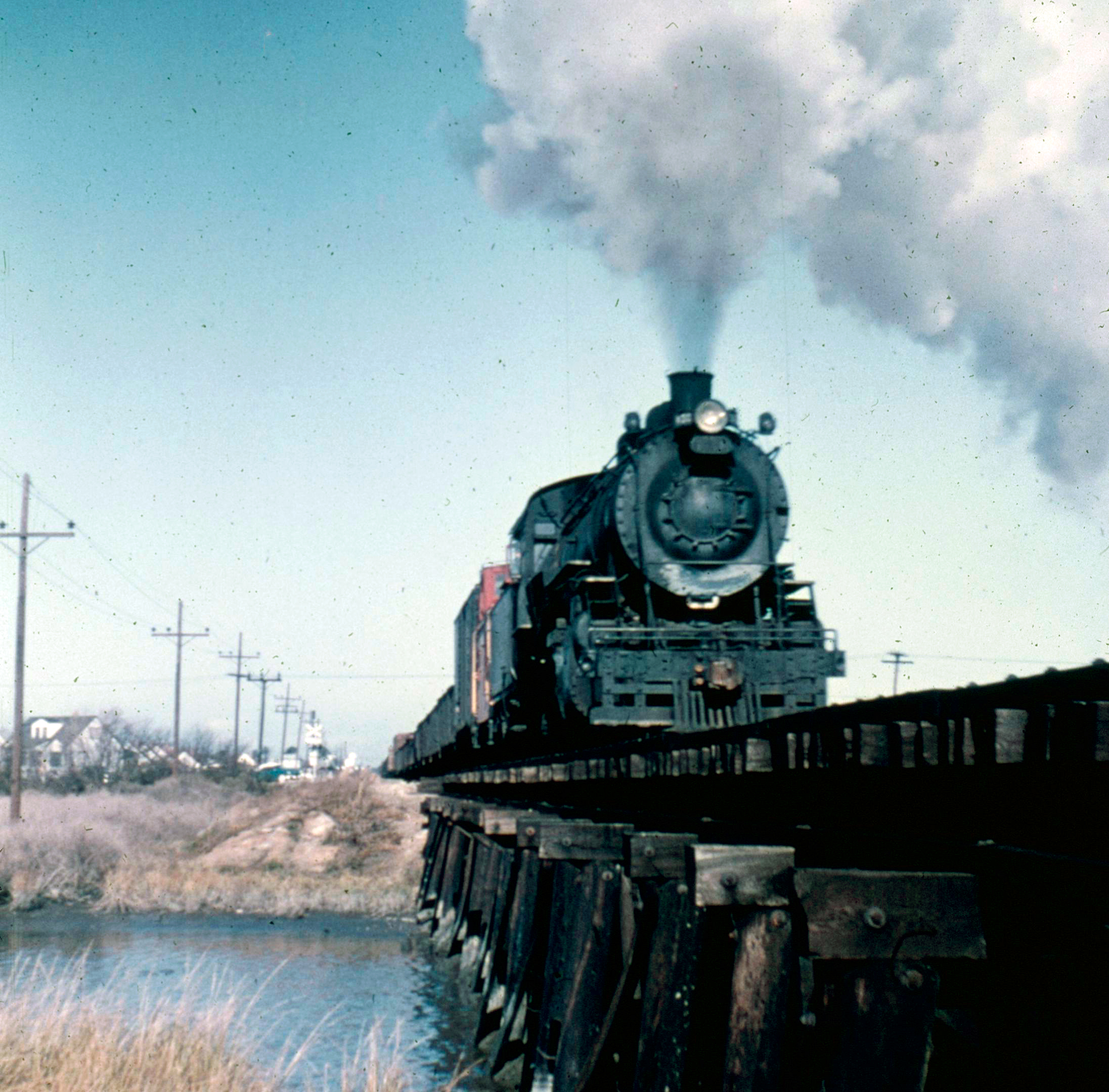 Virginian Railway 2-8-2 #432 (Class MB) leads a westbound freight through Norfolk, Virginia in December, 1954. Author's collection.
Virginian Railway 2-8-2 #432 (Class MB) leads a westbound freight through Norfolk, Virginia in December, 1954. Author's collection.Other railroads that would own several hundred examples of Mikado types include the Baltimore & Ohio, Santa Fe, Chesapeake & Ohio, Burlington, Milwaukee Road, Illinois Central, Louisville & Nashville, Missouri Pacific, Pennsylvania, Southern, and Union Pacific.
Of course, this is just a small fraction of the total; virtually every line of any significant size rostered at least one Mikado and while some were used in passenger service the design was most often employed in freight service due to its eight drivers and overall ability to pull trains weighing 3,000 to 5,000 tons.
Additionally, due to its very layout 2-8-2s were incredibly well balanced machines allowing for easier maintenance and smooth riding.
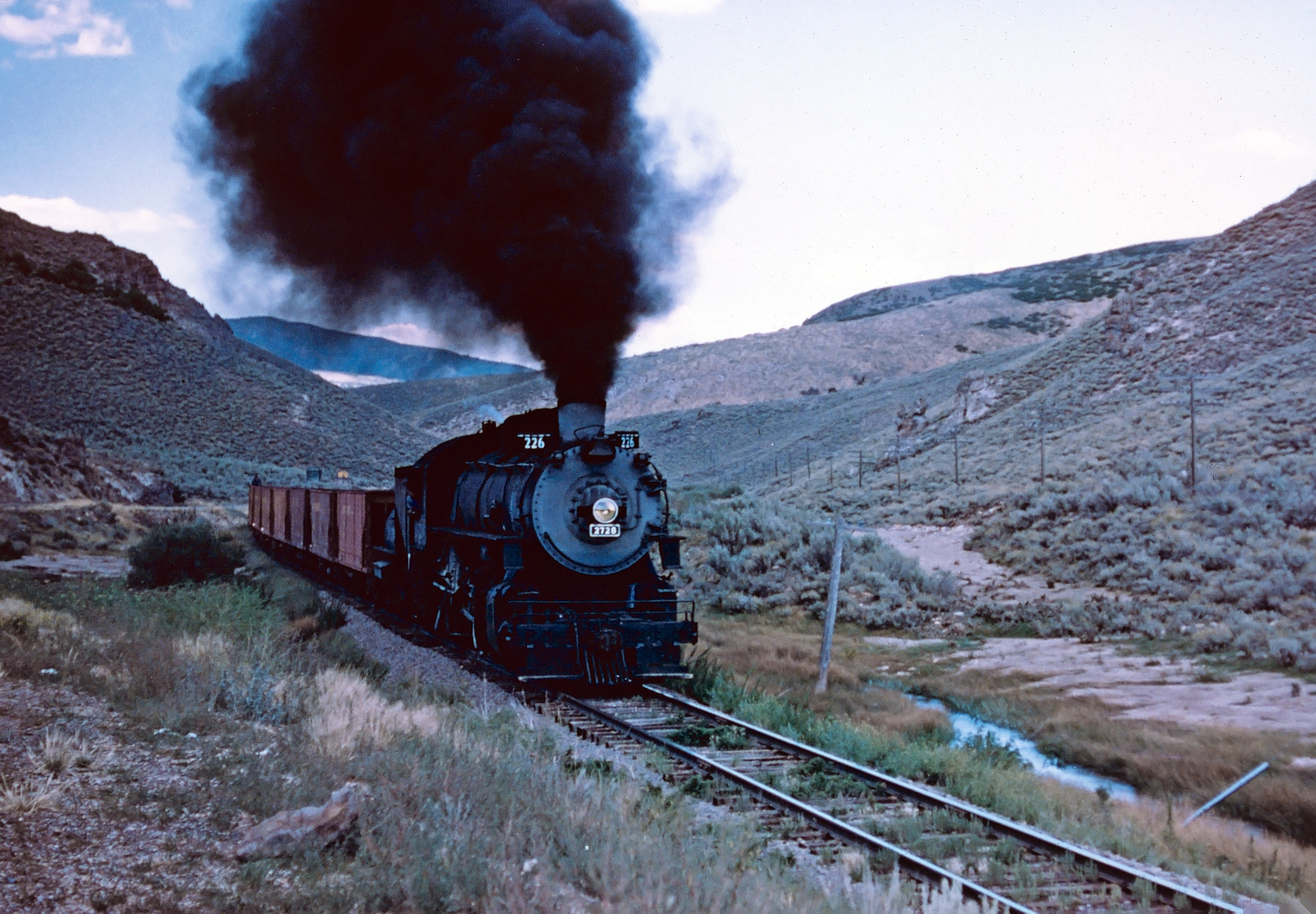 Union Pacific 2-8-2 #2728 works the Park City Branch in Utah with freight #226 on August 9, 1955. The railroad finally called it quits on this line in 1986 when the last 14 loads left Phoston on July 5th that year. John Shaw photo. American-Rails.com collection.
Union Pacific 2-8-2 #2728 works the Park City Branch in Utah with freight #226 on August 9, 1955. The railroad finally called it quits on this line in 1986 when the last 14 loads left Phoston on July 5th that year. John Shaw photo. American-Rails.com collection.Production
Most of the 11,000+ Mikado types built came from the American Locomotive Company (Alco), Baldwin Locomotive Works, or Lima Locomotive Works.
However, a few hundred more were built by the railroads themselves either as an experimentation or in an attempt to save on the cost of purchasing new by having their own shop forces produce the locomotive.
Also, some 2-8-2s built in the U.S. were sent for service in other countries and Mexico went on to purchase several second-hand examples for service south of the border.
Just for historical reference it should noted that during World War II some railroads notably the B&O and Union Pacific, in an attempt to shed the locomotive’s ties to Japan, reclassified their 2-8-2s as "Mac Arthurs" in place of the Mikado name.
Specifications
The below information offers general data on the 2-8-2 wheel arrangement highlighting Baltimore & Ohio's Q-3 2-8-2 "Mac Arthurs." All railroads' Mikados were different in terms of size, power, boiler pressure, tender utilized, etc.
B&O Class Q-3
Chesapeake & Ohio
The Chesapeake & Ohio's first, larger class of freight locomotives included its fleet of 2-8-2 Mikados. These steamers first entered service before World War I and the railroad continued buying them through the 1920s, until the company switched to purchasing "Super Power" designs (beginning with the 2-10-4's of 1930 followed by even more powerful models through World War II).
The C&O listed theirs as Class K and while many were purchased new others came via acquisition of the Hocking Valley Railway (Ohio), Pere Marquette Railway (Michigan), and a short line in West Virginia.
The Mikes remained in service until the early 1950s when the remainder were retired. Alas, no examples of this class were ever preserved.
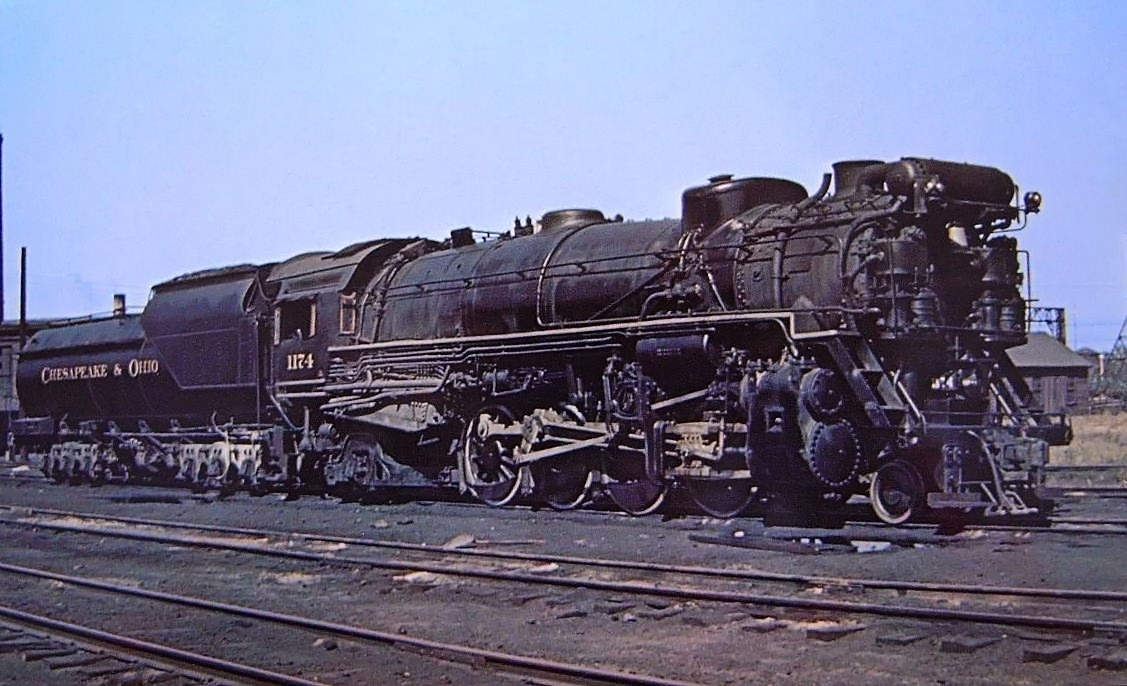 Chesapeake & Ohio 2-8-2 #1174 (K-2), one of many Mikado's built by Alco's Richmond Works for Chessie, is seen here in Chicago circa 1940. Photographer unknown.
Chesapeake & Ohio 2-8-2 #1174 (K-2), one of many Mikado's built by Alco's Richmond Works for Chessie, is seen here in Chicago circa 1940. Photographer unknown.As on most of the large Class I's, C&O's 2-8-2's could be found in all types of freight assignments. They normally handled medium/heavy freights, handling everything from merchandise to coal.
In typical Chessie fashion the Mikes featured the trademark "flying air pumps" on the smokebox, giving them a robust and somewhat intimidating appearance.
The application of a trailing truck on a steam locomotive was nothing new during the late 19th century. However, it had never before been applied to a design sporting four driving axles (eight wheels total).
The first 2-8-2 rolled out on the Lehigh Valley in 1883 as an experimental design born through a rebuilt 2-10-0 Camelback.
The name "Mikado" (referring to a Japanese emperor) was applied to a batch of narrow-gauge 2-8-2s manufactured by the Baldwin Locomotive Works for Japan Railways in 1893.
As the 20th century dawned the wheel arrangement slowly took hold and the first railroad to employ the design in standard road service was coal-hauler Virginian Railway during 1909.
The Chesapeake & Ohio followed closely behind its neighbor acquiring its first 2-8-2 in 1911 from the American Locomotive Company (Richmond Works), listed as Class K-1 and numbered 800 (later renumbered 1100).
At the time the railroad was in the midst of upgrading its fleet to handle both heavier trains and increase speeds on passenger/expedited movements.
Its fleet of 2-8-0s, 4-6-0s, and elderly 4-4-0s could simply no longer handle the modern-day equipment and increasing demand for rail service.
As a result new 4-6-2's began appearing in 1902 followed by its first 2-6-6-2 Mallets in 1910 (Class H-1), and a year later the 4-8-2 Mountains entered service in 1911 (this wheel arrangement was born on the C&O).
The new Mikados would be tasked with freight assignments on the flatter parts of the railroad for increased speeds via heavier trains.
Following its first 2-8-2 the C&O ultimately wound up with sixty examples of K-1's from Alco's Richmond Works (#1100-1159).
At the time they offered ample power for the task at hand providing more than 63,000 pounds of tractive effort, 185 psi boiler pressure, weight of 315,000 pounds, and 57-inch drivers.
Noted C&O historian Eugene Huddleston makes the point that the K-1's were very similar to the railroad's J-1 Mountains without, of course, the additional lead axle and slightly larger drivers (56 inches).
The Mikados performed their jobs well although with ever-increasing demand by the 1920s the C&O was interested in more and placed an order for additional 2-8-2s in 1924.
These considerably larger and more powerful examples were listed as Class K-2 and K-3; once again the C&O stuck with Alco's Richmond Works for the order.
They continued in sequential numbering for the K-2's (#1160-1209) and K-3's (#1210-1259) while the K-3a's were numbered 2300-2349; the new units, not considerably different from one another, slowly arrived on the C&O's property through 1926.
According to Thomas Dixon, Jr.'s book, "Chesapeake & Ohio Railway: A Concise History And Fact Book," the new Mikados offered increased tractive efforts of 67,000 pounds, weighed considerably more (358,000 pounds), and their larger 63-inch drivers provided higher speeds.
The arrival of these 2-8-2s proved to be some of the final non-articulated, non-Super Power designs the C&O purchased as the company opted for ever-larger, more powerful models to handle heavier trains.
Aside from new Mikados the C&O also acquired a batch of units from predecessors; three came from the Kanawha, Glen Jean & Eastern (Class M-4, #300-302), a short line located in West Virginia while eleven others came from the Hocking Valley (another small system based in Ohio), #180-190 (Class M-1).
These Mikes arrived on their respective railroads between 1910 and 1912; the KGJ&E's were very light weighing only 217,300 pounds with tractive efforts of just 46,000 pounds while the HV's were similar to the K-1's providing around 60,000 pounds of tractive effort.
Once folded into the C&O roster the units were renumbered into the K class along with their other counterparts. Finally, there was a large batch of 2-8-2s that arrived from much larger predecessor Pere Marquette during 1947.
The PM was a rather significant road serving its home state of Michigan and owned a substantial number of Mikados totaling fifty units, #1101-1150, acquired between 1913 and 1927.
These steamers were built by Baldwin and Alco while the rest of is roster came second-hand from the Wabash, Erie Railroad, New York Central, and Indiana Harbor Belt.
None were as powerful as the Class K models with tractive efforts hovering around 55,00 pounds. Under the C&O the units were listed as Class K-5 through K-8.
Most of these were retired or scrapped a few years after World War II while most of the C&O's other 2-8-2s continued in service until the early 1950s when diesels began arriving.
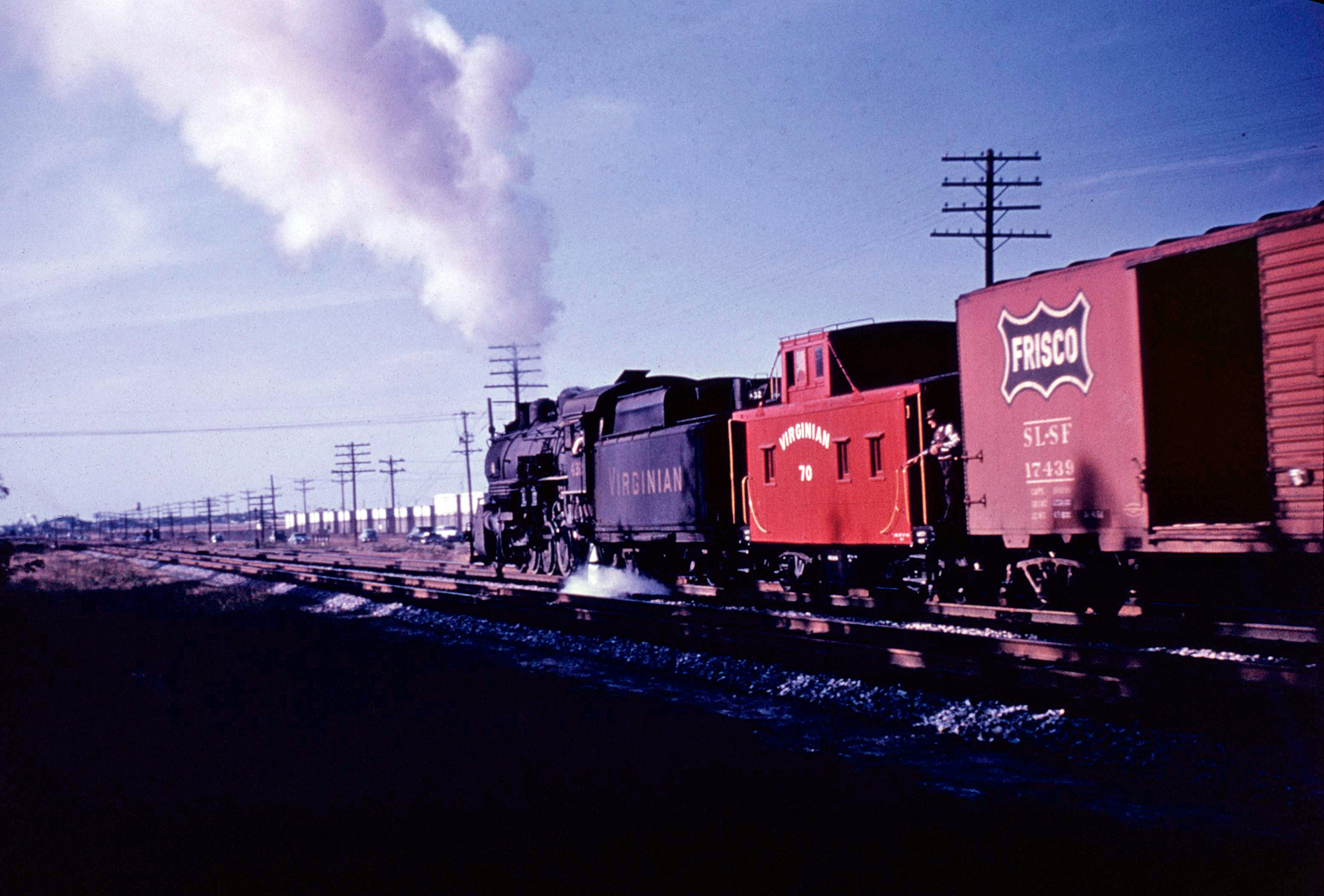 Virginian Railway 2-8-2 #432 works the Naval Air Station in Norfolk, Virginia during October of 1954. H. Reid photo. American-Rails.com collection.
Virginian Railway 2-8-2 #432 works the Naval Air Station in Norfolk, Virginia during October of 1954. H. Reid photo. American-Rails.com collection.Preservation
Today, several Mikado Types survive around the country, such as beautifully restored Southern #4501 at the Tennessee Valley Railroad Museum and Southern Pacific Class Mk-5 #745, owned by the Louisiana Steam Train Association.
The largest batch of Mikes still in service are the Rio Grande's various Class K narrow-gauge examples in operation on the Cumbres & Toltec Scenic and Durango & Silverton (as well as one on the Huckleberry Railroad in Michigan).
Several others are not mentioned here due to the shear number, which does not even include the several others currently in some state of restoration. The site also provides a long, detailed list of operating and preserved Mikes found around the country.
Photo Gallery
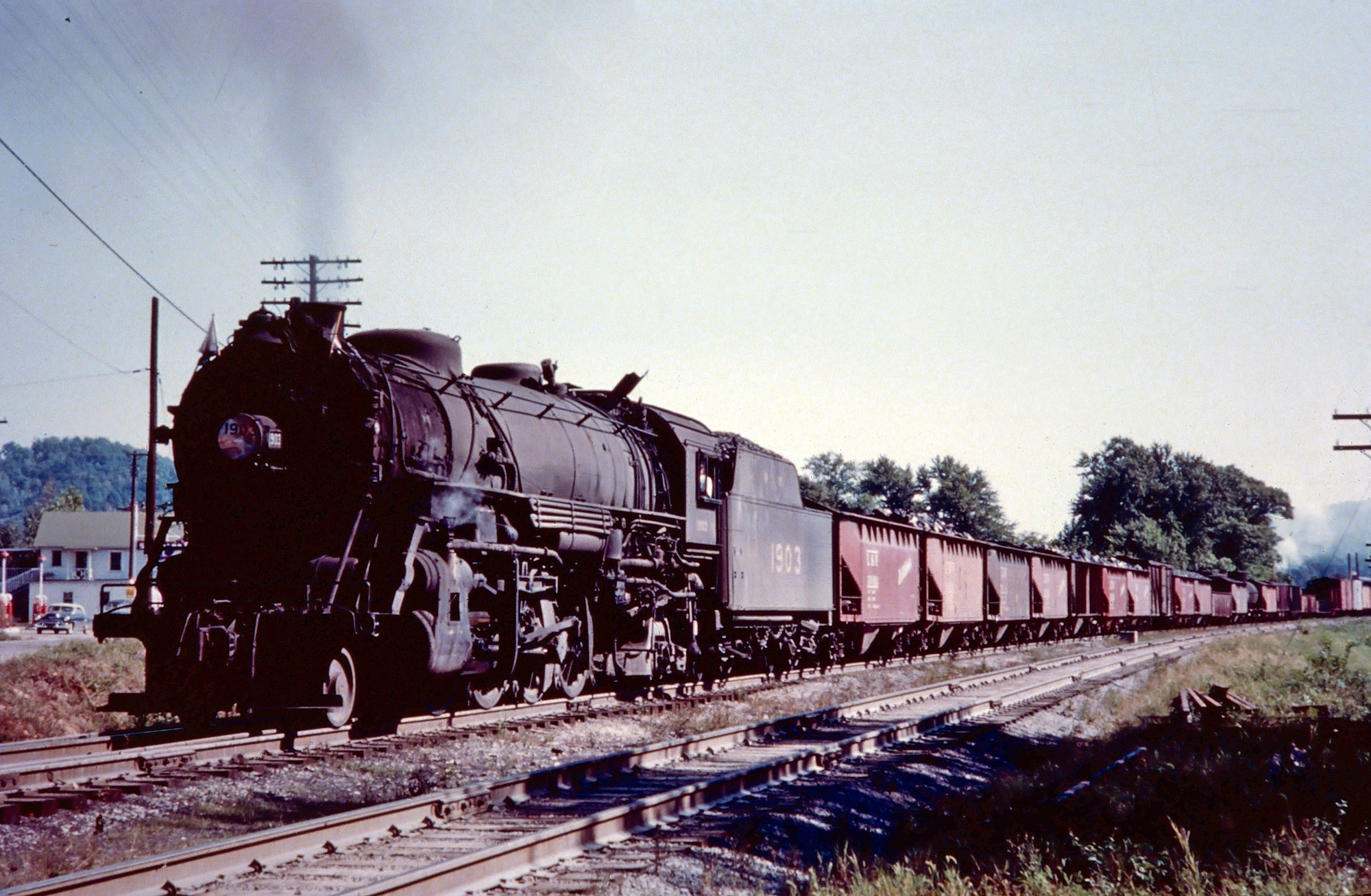 Louisville & Nashville 2-8-2 #1903 was photographed here by Homer Newlon, Jr. with an eastbound freight at Artemus, Kentucky on September 5, 1953. American-Rails.com collection.
Louisville & Nashville 2-8-2 #1903 was photographed here by Homer Newlon, Jr. with an eastbound freight at Artemus, Kentucky on September 5, 1953. American-Rails.com collection.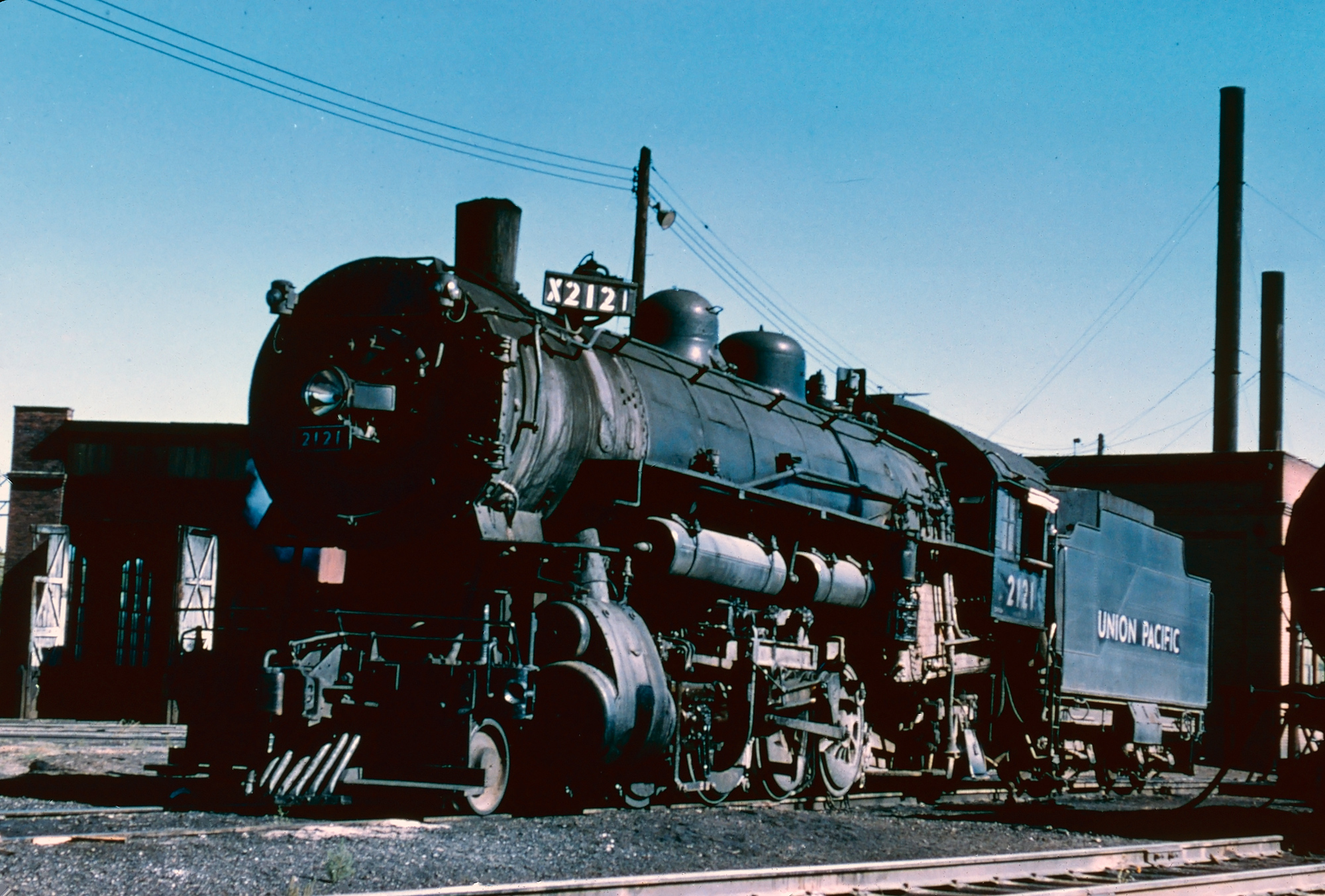 Union Pacific 2-8-2 #2121 lays over at the roundhouse in LaSalle, Colorado on September 1, 1955. John Shaw photo. American-Rails.com collection.
Union Pacific 2-8-2 #2121 lays over at the roundhouse in LaSalle, Colorado on September 1, 1955. John Shaw photo. American-Rails.com collection.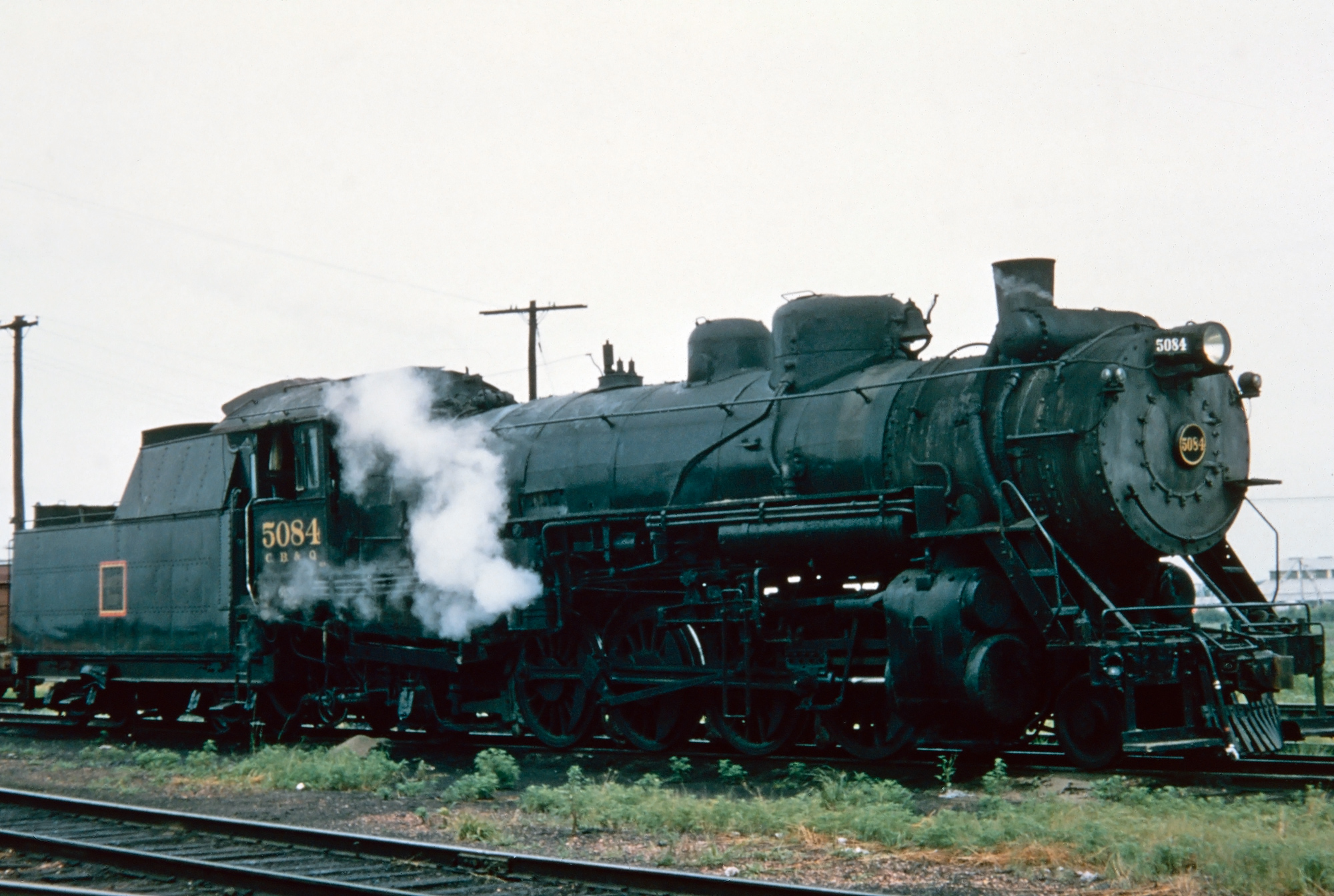 Burlington 2-8-2 #5084 (O-1-A) in her final years of service at Lincoln, Nebraska, circa 1952. American-Rails.com collection.
Burlington 2-8-2 #5084 (O-1-A) in her final years of service at Lincoln, Nebraska, circa 1952. American-Rails.com collection.Survivors
| Original Owner | Road Number | Class | Wheel Arrangement | Gauge | Current Owner | Location | Builder | Serial Number | Year Built |
|---|---|---|---|---|---|---|---|---|---|
| D&RGW | 494 | K-37 | 2-8-2 | Narrow-Gauge (36") | Cumbres & Toltec Scenic | Antonito, CO | Baldwin | #20748 | 1928 |
| D&RGW | 495 | K-37 | 2-8-2 | Narrow-Gauge (36") | Cumbres & Toltec Scenic | Antonito, CO | Baldwin | #20522 | 1928 |
| Santa Maria Valley Railroad | 21 | - | 2-8-2 | Standard | Astoria RR Preservation | Astoria, OR | Baldwin | #58368 | 1925 |
| Georgia Railroad | 302 | F | 2-8-2 | Standard | Augusta Museum of History | Augusta, GA | Lima | #5004 | 1915 |
| Southern Pacific (T&NO) | 786 | Mk-5 | 2-8-2 | Standard | Austin Steam Train Association | Austin, TX | Alco (Brooks) | #55972 | 1916 |
| B&O | 4500 | Q3 | 2-8-2 | Standard | B&O Railroad Museum | Baltimore, MD | Baldwin | #49153 | 1918 |
| PRR/SLSF (1923) | 4018 | (USRA) | 2-8-2 | Standard | Sloss Furnaces National Historical Landmark | Birmingham, AL | Lima | #5872 | 1919 |
| Nickel Plate Road | 639 | H-6d | 2-8-2 | Standard | Bloomington, IL | Miller Park | Lima | #6642 | 1923 |
| U.S. Army Transportation Corps/White Pass & Yukon | 190 ("Yukon Queen") | S118 | 2-8-2 | Narrow Gauge (36") | Tweetsie Railroad | Blowing Rock, NC (Operational) | Baldwin | #69425 | 1943 |
| Union Pacific | 2295 | MK-9 | 2-8-2 | Standard | City of Boise, ID | Boise Depot | Alco (Brooks) | #61924 | 1924 |
| China Railways | 8419 | JS | 2-8-2 | Standard | Boone & Scenic Valley Railroad | Boone, IA (Operational) | Datong Works | #8419 | 1989 |
| Pacific Lumber | 35 | - | 2-8-2 | Standard | Nevada State Railroad Museum | Boulder City, NV | Baldwin | #57538 | 10/1923 |
| Dierks Lumber & Coal | 227 | 12-32 1/4-E | 2-8-2 | Standard | City of Broken Bow, OK | 224 South Park Drive | Baldwin | #60006 | 1927 |
| W. T. Carter & Brothers Lumber | 14 | - | 2-8-2 | Standard | WT Carter Estate | Camden, TX | Baldwin | #56917 | 1923 |
| Albany & Northern | 9 | 2-8-2 | Standard | City of Camilla, GA | Local Park (West Broad Street) | Baldwin | #58361 | 1925 | |
| Coos Bay Lumber | 11 | - | 2-8-2T | Standard | Pacific Southwest Railway Museum | Campo, CA | Alco (Schenectady) | #68276 | 1929 |
| SLSF (Frisco) | 1352 | - | 2-8-2 | Standard | Aberdeen, Carolina & Western | Candor, NC (Stored) | Alco (Schenectady) | #51820 | 9/1912 |
| D&RGW | 499 | K-37 | 2-8-2 | Narrow Gaugee (36") | Canon City, CO | Royal Gorge Park | Baldwin | #20753> | 1930 |
| D&RGW | 483 | K-36 | 2-8-2 | Narrow Gauge (36") | Cumbres & Toltec Scenic | Chama, NM | Baldwin | #58584 | 1925 |
| D&RGW | 484 | K-36 | 2-8-2 | Narrow Gauge (36") | Cumbres & Toltec Scenic (Operational) | Chama, NM | Baldwin | #58585 | 1925 |
| D&RGW | 487 | K-36 | 2-8-2 | Narrow Gauge (36") | Cumbres & Toltec Scenic | Chama, NM | Baldwin | #58588 | 1925 |
| D&RGW | 488 | K-36 | 2-8-2 | Narrow Gauge (36") | Cumbres & Toltect Scenic (Operational) | Chama, NM | Baldwin | #58589 | 1925 |
| D&RGW | 489 | K-36 | 2-8-2 | Narrow Gauge (36") | Cumbres & Toltec Scenic (Operational) | Chama, NM | Baldwin | #58590 | 1925 |
| D&RGW | 492 | K-37 | 2-8-2 | Narrow Gauge (36") | Cumbres & Toltec Scenic | Chama, NM | Baldwin | #20749 | 1928 |
Sources
- Boyd, Jim. American Freight Train, The. Osceola: MBI Publishing, 2001.
- Dixon, Thomas W. Chesapeake And Ohio Railway: A Concise History And Fact Book. Clifton Forge: Chesapeake & Ohio Historical Society, 2012.
- Dixon, Thomas W. Chesapeake & Ohio K-4 Class 2-8-4 Steam Locomotives. Clifton Forge: Chesapeake & Ohio Historical Society, 2013.
- Dixon, Thomas W. Chesapeake & Ohio Passenger Service: 1847-1971. Clifton Forge: Chesapeake & Ohio Historical Society, 2013.
- Edson, William D. Steam Locomotives Of The Baltimore & Ohio: An All-Time Roster. Potomac: William D. Edson, 1992.
- Mainey, David. Baltimore & Ohio Steam In Color. Scotch Plains: Morning Sun Books, 2001.
- Morrison, Tom. American Steam Locomotive In The Twentieth Century. Jefferson: McFarland & Company, Inc., 2019.
- Simpson, Walter. Steam Locomotive Energy Story, The. New York: American University Presses, 2021.
- Solomon, Brian. Classic Locomotives, Steam And Diesel Power in 700 Photographs. Minneapolis: Voyageur Press, 2013.
